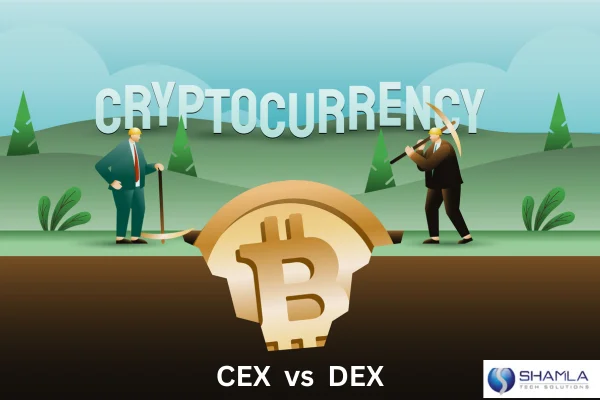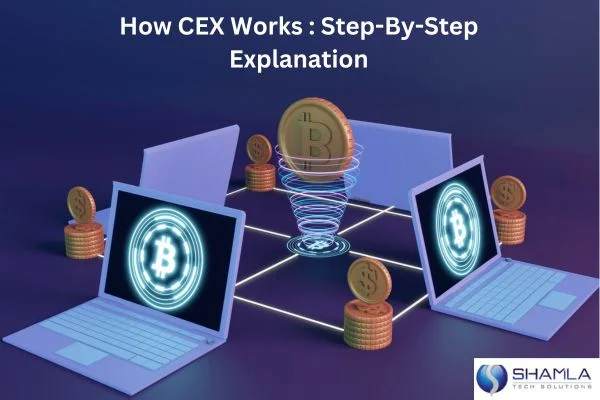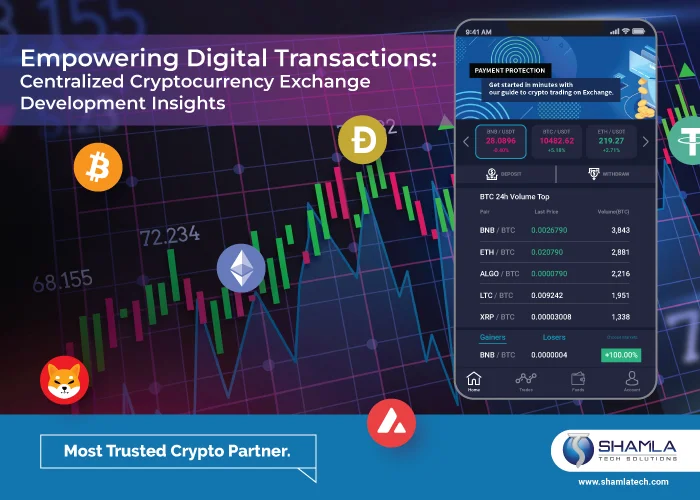Centralized cryptocurrency exchanges are integral to the digital asset landscape, offering a secure and efficient trading platform for users worldwide. These platforms offer a convenient and user-friendly way for individuals to buy, sell, and trade digital assets. In this article, we will explore the basics of centralized crypto exchange development and its significance in the cryptocurrency ecosystem. We will delve into the key features, functionalities, and benefits that make these exchanges popular among traders and investors.
From order-matching engines to user authentication and regulatory compliance, we’ll explore the multifaceted aspects that contribute to the success of centralized exchanges in the dynamic realm of cryptocurrency trading. By understanding the intricacies of centralized crypto exchange development, we can better appreciate the advancements and potential that lie ahead in this dynamic industry.
A centralized exchange is a digital platform that facilitates the buying, selling, and trading of cryptocurrencies through a centralized authority or intermediary. In this system, the exchange acts as a trusted third party, managing user accounts, order matching, and transaction settlement. Users deposit their funds into exchange-controlled wallets, and the exchange maintains order books, facilitating trade execution.
While centralized exchanges offer user-friendly interfaces and high liquidity, they require users to relinquish control of their private keys, posing security concerns. Additionally, they are subject to regulatory compliance, including Know Your Customer (KYC) and Anti-Money Laundering (AML) procedures, making them more susceptible to government oversight compared to decentralized alternatives.
Centralized cryptocurrency exchange development involves several key steps and considerations. Here is a general overview of centralized crypto exchange development.
Begin by gaining a comprehensive understanding of the cryptocurrency market dynamics. Identify and define your target audience within this vast and evolving ecosystem. Analyze existing competitors and scrutinize their features to discern market trends. Simultaneously, investigate and comprehend the diverse regulatory requirements and compliance standards prevalent in the regions where you plan to operate.
Collaborate with legal experts to navigate the intricate landscape of cryptocurrency regulations. Ensure that your exchange adheres to local legal requirements by obtaining the necessary licenses and approvals. This step is crucial to establishing a solid legal foundation and fostering trust among users.
Carefully outline the features and functionalities of your exchange. Determine which cryptocurrencies will be supported and establish the trading pairs available to users. Implement a variety of order types, such as market orders, limit orders, and stop orders. Integrate essential features like wallet functionality, two-factor authentication, and robust Know Your Customer (KYC) and Anti-Money Laundering (AML) processes.
Select a technology stack that aligns with your exchange’s needs. Opt for a reliable and scalable combination of backend and frontend technologies. Consider programming languages like Python, Java, or Node.js for the backend, and choose a secure and efficient database system to ensure optimal performance and security.
Prioritize the implementation of robust security measures. Utilize encryption techniques to safeguard user data. Employ Distributed Denial of Service (DDoS) protection mechanisms to ensure uninterrupted service. Store cryptocurrency assets in both cold and hot wallets, and conduct regular security audits and vulnerability assessments to identify and rectify potential threats.
Devote attention to creating an intuitive and user-friendly interface. Ensure that users can seamlessly navigate the platform on various devices and screen sizes. A well-designed UI/UX contributes significantly to user satisfaction and retention.
Integrate reliable payment gateways to facilitate seamless deposits and withdrawals. Accommodate both fiat-to-crypto and crypto-to-crypto trading pairs to provide users with diverse trading options.
Develop and implement comprehensive KYC/AML procedures. These procedures are crucial for meeting regulatory requirements and maintaining the integrity of your exchange. Efficient identity verification processes contribute to a secure and compliant user environment.
Establish partnerships with liquidity providers to ensure a consistent and robust liquidity pool on your platform. Implement effective strategies to manage and maintain liquidity, providing users with a smooth trading experience.
Thoroughly test all aspects of the platform, including security, performance, and user acceptance. Identify and rectify any issues before the official launch to ensure a stable and reliable user experience.
Roll out your exchange in a phased manner, beginning with a limited release. Monitor the platform closely for any issues and address them promptly. This phased approach allows for real-time adjustments and improvements.
Create an all-encompassing marketing plan aimed at drawing users to your platform. Additionally, invest in robust customer support mechanisms to address user queries and concerns promptly. A positive and supportive user experience is key to building trust and loyalty.
Stay abreast of regulatory changes and adjust your platform accordingly. Collaborate continuously with legal experts to ensure ongoing compliance with evolving regulations. This proactive approach is essential for the sustained success and longevity of your centralized exchange.
Centralized Exchanges (CEX) and Decentralized Exchanges (DEX) each bring unique advantages to the vibrant world of cryptocurrency trading.
Centralized exchanges offer a seamless and user-friendly experience, making them ideal for beginners and those seeking convenience. With robust liquidity and a broad range of trading pairs, CEXs facilitate swift and efficient transactions. Their compliance with regulatory standards, including Know Your Customer (KYC) and Anti-Money Laundering (AML) procedures, enhances user security and aligns with legal requirements. Furthermore, centralized exchanges often employ advanced security measures, providing users with a reliable platform for trading and asset management.
Decentralized exchanges champion user autonomy and privacy. By allowing users to retain control of their private keys and trade directly from their wallets, DEXs eliminate the need for intermediaries, fostering a trustless environment. The decentralized nature of these platforms reduces the risk of large-scale hacks, offering a secure space for users to engage in peer-to-peer trading. Additionally, DEXs contribute to the broader ethos of blockchain technology by promoting financial inclusivity and accessibility.
Centralized cryptocurrency exchange development offers several benefits, contributing to the widespread adoption and success of these platforms in the digital asset landscape:
Centralized exchanges prioritize creating interfaces that are user-friendly and easy to navigate. This is essential for attracting a diverse user base, including individuals who may be new to cryptocurrency trading. Intuitive interfaces make it simpler for users to execute trades, monitor market movements, and manage their portfolios efficiently.
The centralized nature of exchanges allows for the consolidation of trading activity on a single platform. This concentration of users results in higher liquidity, meaning there are more buyers and sellers, reducing the impact of large trades on the market price. High liquidity is attractive to traders as it enables smoother and more cost-effective transactions.
Centralized exchanges operate with centralized order matching engines, facilitating quick trade execution. This is crucial in a fast-paced market where prices can change rapidly. Users benefit from the ability to execute trades promptly, responding to market fluctuations in real-time.
Centralized exchanges offer a diverse selection of trading pairs, allowing users to trade various cryptocurrencies against each other or against fiat currencies. This extensive range of options provides traders with flexibility and the opportunity to explore different markets.
Security is paramount for centralized exchanges. They implement robust measures such as data encryption, two-factor authentication (2FA), and secure socket layer (SSL) protocols. Cold storage solutions for user funds and regular security audits help safeguard against unauthorized access and protect users’ assets.
Centralized exchanges typically provide customer support services to assist users with any issues or queries they may have. This support can include troubleshooting, guidance on platform features, and assistance with account-related matters, contributing to an overall positive user experience.
To attract and retain users, centralized exchanges often introduce incentive programs. These programs may include reduced trading fees for high-volume traders, referral bonuses for bringing in new users, or loyalty programs that reward consistent trading activity. Incentive programs contribute to a more engaging and competitive trading environment.
Many centralized exchanges engage in market-making activities, either through proprietary trading desks or partnerships with liquidity providers. These activities contribute to maintaining liquidity by actively participating in the market, providing continuous bid and ask orders, and narrowing bid-ask spreads.
Centralized exchanges often play a crucial role in the growth of new blockchain projects by facilitating the listing of their tokens. This exposure benefits both the exchange, as it attracts new users interested in trading these tokens, and the projects, as they gain access to a broader audience. Partnerships between exchanges and blockchain projects further enhance the overall ecosystem.
Centralized cryptocurrency exchange development encompasses a comprehensive approach to user experience, security, regulatory compliance, and market dynamics, fostering an environment that caters to the needs of a diverse and growing cryptocurrency community.
A Centralized Exchange (CEX) operates as an intermediary facilitating the buying, selling, and trading of cryptocurrencies. Here’s a step-by-step explanation of how a typical CEX works:
Users begin by creating accounts on the centralized exchange platform. During this process, they provide necessary information, including personal details, and often undergo Know Your Customer (KYC) procedures for identity verification.
Once registered, users fund their exchange accounts. This involves depositing cryptocurrencies or fiat currencies into wallets provided by the exchange. The exchange manages these wallets on behalf of users.
Users can place various types of orders, such as market orders (executed immediately at the current market price) or limit orders (executed at a specific price or better). These orders are recorded in the exchange’s order book.
The exchange’s order-matching engine continually matches buy and sell orders based on predefined rules. When a buyer’s bid matches a seller’s ask, a trade is executed, and ownership of the assets is transferred.
The trade is executed at the agreed-upon price, and the cryptocurrency ownership is updated. Centralized exchanges provide a centralized ledger that records all transactions and account balances.
The order book is continuously updated as new orders are placed and existing orders are executed. This transparency allows users to view the current market demand and supply for each trading pair.
Users can withdraw their funds or deposit additional assets into their exchange accounts. Withdrawals often require additional security measures, such as two-factor authentication (2FA), to ensure the security of user accounts.
CEXs provide users with a user-friendly interface, including trading dashboards, charts, and tools for technical analysis. These interfaces aim to make the trading experience intuitive and efficient.
Centralized exchanges typically charge fees for various services, such as trading fees, withdrawal fees, and, in some cases, listing fees for new tokens. Fee structures may vary, and some exchanges offer reduced fees for high-volume traders or users holding their native utility tokens.
Centralized Exchange acts as an intermediary that manages user accounts, facilitates order matching, and ensures the secure and efficient execution of trades within the cryptocurrency market. The centralized nature of these exchanges provides a familiar and user-friendly environment for traders, making them a popular choice for a wide range of users in the cryptocurrency ecosystem.





